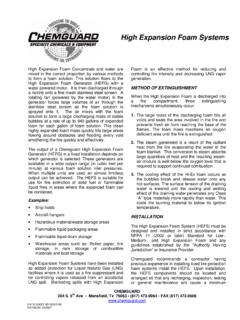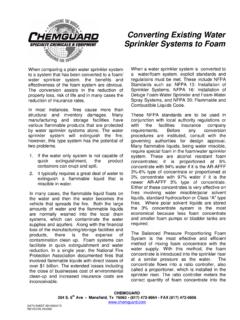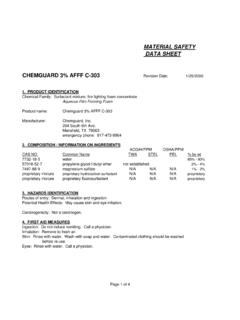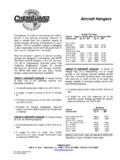Transcription of Fixed or Semi-Fixed Fire Protection Systems for Storage …
1 Fixed or semi - Fixed fire Protection Systems for Storage tanks In the early years of the oil industry, fire in a Storage tank was a common occurrence. Virtually all products were stored in cone roof tanks built of riveted steel plates and the roof was often constructed with wood and tar coated paper. Tank fires were common especially after a lightning storm. This costly experience gradually led to improvements in better codes and guidelines for handling Storage tank fires. floating roof tanks were adopted for low flash point petroleum products and proved to be a most reliable method of Protection against losses due to fires. The less volatile products with higher flash points continue to be stored in welded steel cone roof tanks .
2 As the frequency of fully involved Storage tank fires decreases to a more acceptable level, the size of fire , when it happens, becomes larger due to the increase in tank size and capacity. It is quite common to see tanks with diameters in excess of 328 ft. (100 meters) capable of storing a million barrels of product. One practical method to protect flammable liquid Storage tanks from fire is with a Fixed or a semi - Fixed foam fire Protection system . When engineered, installed and maintained correctly, these Systems will give many years of reliable service. The foam system can be used for fire prevention, control or direct extinguishment of any flammable or combustible liquid fire within the tank.
3 To select the correct foam system , it is necessary to understand the following Systems : Fixed system is a complete installation piped from a central foam station, discharging through Fixed discharge devices on the hazard being protected? Foam proportioning components are permanently installed. semi Fixed system is an installation where the hazard is equipped with Fixed discharge device(s), which connect to piping that terminates a safe distance from the hazard, normally outside the dike wall. Foam producing materials are transported to the scene after the fire starts and are connected to the piping. Listed below are types of tanks commonly used for the Storage of combustible or flammable liquids. Cone roof tank Open top floating roof tank Internal floating roof tank/covered floating roof Cone roof Storage Tank has vertical sides and is equipped with a Fixed cone-shaped roof that is welded to the sides of the tank.
4 tanks that have been designed in accordance with API standards have a weak seam at the joint where the roof and sides meet. In the event of an internal explosion, the roof separates and blows off leaving the tank shell intact. This system allows the tank to retain its contents and any resulting fire will involve the full surface of the exposed flammable liquid. Open Top floating roof Storage Tank is similar to the cone roof tank in construction but with the exception that it has no Fixed roof . A pontoon type roof floats directly on the flammable liquid surface. This floating roof has a mechanical shoe or tube seal attached to its full perimeter. The rim seal covers the space between the floating roof and the tank shell (side wall).
5 Internal floating roof /Covered floating roof Storage Tank is a combination of both the cone roof and the open top- floating roof tank? The tank has a cone roof but with the addition of an internal floating roof or pan that floats directly on the fuel surface. The open vents in the tank sidewalls just beneath the roof joint can identify this type of tank. If the internal floating roof is other than a steel double deck or pontoon type, the fire Protection system should be designed for full surface fires (similar to cone roof tanks ). For the double deck or pontoon internal roofs of steel construction, a design for sealed area Protection may be permitted (same as open floating roof tanks ). Small quantities of flammable liquids are sometimes stored in horizontal style tanks , which normally sit on saddles or in underground Storage facilities.
6 This section applies only to the three major types of tanks as listed above. CHEMGUARD 204 S. 6th Ave Mansfield, Tx 76063 (817) 473-9964 FAX (817) 473-0606 DATA SHEET #D10D03190 REVISON: 09/2005 CHEMGUARD 204 S. 6th Ave Mansfield, Tx 76063 (817) 473-9964 FAX (817) 473-0606 THE FLAMMABLE LIQUID There are two basic classifications of flammable and combustible liquids: Hydrocarbon (non water miscible) Polar Solvent (water miscible) Hydrocarbons include non water-soluble petroleum liquids such as crude oil, gasoline, jet fuels, fuel oils, etc. Polar solvents include water soluble liquids such as alcohols, ketones, esters etc. All Chemguard Listed and standard grade foam concentrates are suitable for use on hydrocarbon fuel fires or spills.
7 Only Chemguard Listed and standard grade alcohol resistant AR-AFFF concentrates are suitable for use on polar solvent fuel fires or spills. NOTE: Pure MTBE is only slightly water miscible (approx. 4% - 6%). FLAMMABLE AND COMBUSTIBLE LIQUIDS PER NFPA 30 Flammable Liquid means liquid having a flash point below 100 F ( C) and having a vapor pressure not exceeding 40 psi (276 kpa)(absolute) at 100 F ( C) shall be known as a Class I liquid. Class I liquids shall be subdivided as follows: Class IA includes those having flash points below 73 F ( C) and having a boiling point below 100 F ( C). Class IB includes those having flash points below 73 F ( C) and having a boiling point above 100 F ( C).
8 Class IC includes those having flash points at or above 73 F ( C) and below 100 F ( C). Combustible Liquid means liquid having a flash point at or above 100 F ( C). Combustible liquids shall be subdivided as follows: Class II includes liquids with having flash points at or above 100 F ( C) and below 140 F (60 C). Class IIIA includes liquids with a flash points at or above 140 F (60 C) and below 200 F ( C). Class IIIB includes liquids with having flash points at or above 200 F ( C). fire Protection OF Storage tanks has established two different types of foam discharge outlets: Type II Discharge Outlet - A Fixed device that delivers foam onto the burning liquid and partially submerges the foam and produces restricted agitation of the surface.
9 Examples of this type of device are Foam Chambers and Foam Makers. Type III Discharge Outlet - A Fixed or portable device that delivers foam in a manner that causes the foam to fall directly onto the surface of the burning liquid in such a way that causes general agitation. Examples of this type of device are Hose Stream Nozzles and Monitors. Two basic methods of fire Protection Systems for Storage tanks : Sub-surface Base Injection Over the Top - (Subdivided as follows) Foam Chambers, Foam Makers, Portable Foam Monitors and Foam Tower SUB-SURFACE BASE INJECTION The sub-surface method of fire Protection produces foam with a HBPFM located outside the Storage tank. This system delivers the expanded foam mass through piping into the base of the tank.
10 The pipe may be an existing product line or can be a dedicated fire Protection foam line. The expanded foam entering the tank through a discharge outlet is injected into the flammable liquid. The discharge outlet must be a minimum of 1 ft. above any water that may be present at the base of the tank. The foam will be destroyed if injected into the water layer. When injected into the fuel, the foam will rise through the fuel and form a vapor tight foam blanket on the fuel surface. Advantages of Sub-Surface The rising foam can cause the fuel in the tank to circulate which can assist in cooling the fuel at the surface. If there is an explosion and fire that could damage the top of the tank, the sub-surface injection system is not likely to suffer damage The discharging foam is more efficiently directed to the fuel surface without any interruption from the thermal updraft of the fire .







